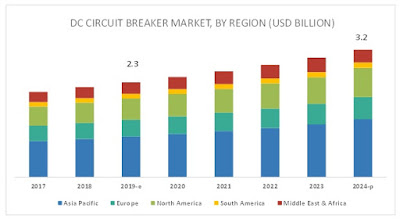The offshore wind market has been rapidly growing,
especially in Europe as it contributed to the European Union (EU) to meet its renewable energy targets for 2020. The market in Europe
was estimated to be the largest market for offshore wind, followed by Asia-Pacific
in 2016. This trend is expected to continue till 2022. The growth of the offshore
wind market is driven by an increasing share of renewable energy in power
generation, energy efficiency mandates demanding carbon emission reduction, and
government incentives supporting renewable energy deployment. The global demand
for electric power is increasing due to various factors such as urbanization,
increased industrialization, and economic development among others. Rising
energy demand and energy efficiency mandates drive the demand for the offshore
wind market.
Offshore Wind Market is projected to grow from an
estimated USD 27.02 Billion in 2017 to USD 55.11 Billion by 2022, at a CAGR of
15.32% from 2017 to 2022.
Browse
65 market data tables and 64 figures spread through 147 pages and in-depth TOC
on "Offshore Wind Market”
View
detailed Table of Content here - https://www.marketsandmarkets.com/Market-Reports/offshore-wind-market-253452593.html
The North America
market is projected to grow at the highest CAGR from 2017 to 2022. North
America is estimated to be the fastest growing market for the offshore wind
market from 2017 to 2022. The U.S. is the only country that had commercial
offshore wind operations in this region as of 2016. This region is in the early
phase of implementing offshore wind farms. They are partnering with other
European countries to develop advanced technologies in order to efficiently
install offshore wind turbines. According to the Department of Energy, the U.S.
has the potential to produce 7,200 terawatt hours of electricity per year
through offshore wind. North America is looking at renewable energy generation
in a way to meet its energy needs at affordable costs and minimum environmental
damage, thus, driving the market for offshore wind.
Scope of the Offshore
Wind Market Report:
By Component
·
Turbine
§
Nacelle
§
Tower
§
Rotor
& Blades
·
Substructure
§
Monopile
§
Gravity
based and Jacket
§
Other
substructure (Suction Bucket, Tripods, Tripiles, and Floating)
·
Electrical
Infrastructure
·
Others
(Logistics and transportation, and Installation and assembly)
By Location
·
Shallow
water (< 30 m depth)
·
Transitional
water (30 m–60 m depth)
·
Deep
water (> 60 m depth)
By Region
·
North
America
·
Europe
·
Asia-Pacific
Download PDF
Brochure @ https://www.marketsandmarkets.com/pdfdownloadNew.asp?id=253452593
Offshore Wind
Market Ecosystem:
The market ecosystem comprises of turbine manufacturers, electrical
infrastructure manufacturers, installation providers, substructure providers,
and logistics, transportation and assembly providers. Leading players in the market includes Siemens AG (Germany), ABB, Ltd.
(Switzerland), A2Sea (Denmark), Nexans (France), EEW Group (Germany), and
General Electric (U.S.) among others.
The report segments the offshore wind market by location
into three categories, namely, shallow water, transitional water, and deep
water. Deep water location is expected to grow at the fastest rate during the
forecast period. As the offshore wind market is progressing over the years, the
offshore wind farms are getting built further from the coast and in deeper
waters. The offshore wind sector is developing larger turbines as the trend is
moving towards deep water where the wind speed is high. This would help in
optimization of wind connections and generate power efficiently. Although, the
market for offshore
wind in deep water location accounts less share compared to shallow water
and transitional water. It is still expected to grow at a faster rate from 2017
to 2022. Companies like MHI Vestas (Denmark), A2Sea (Denmark), and Siemens AG
(Germany), among others supply turbine and related components that can operate
in a depth of 60 meters.



